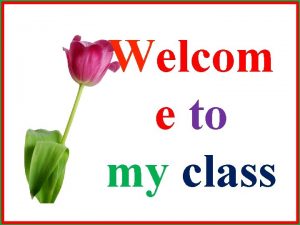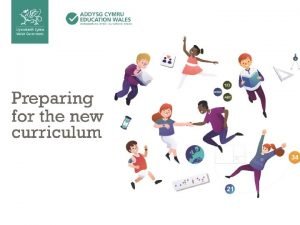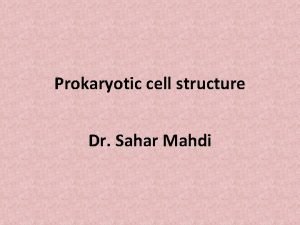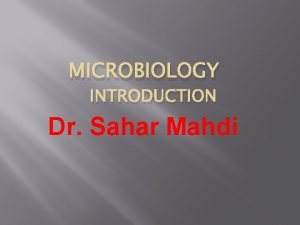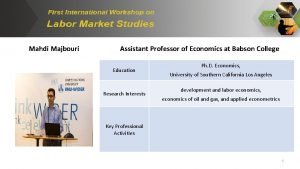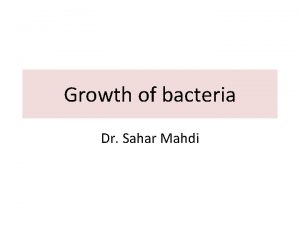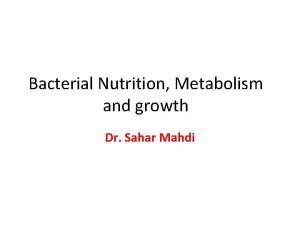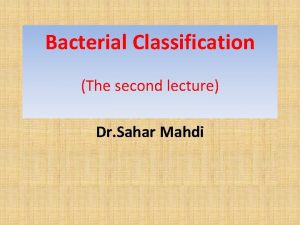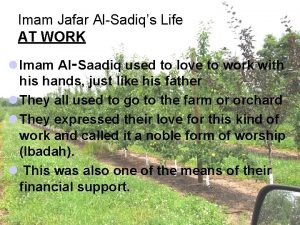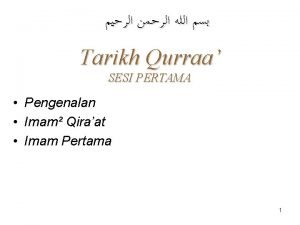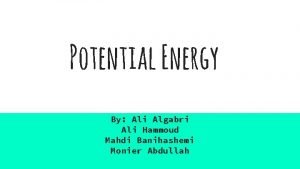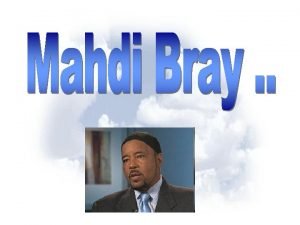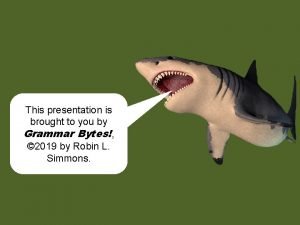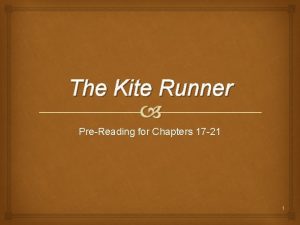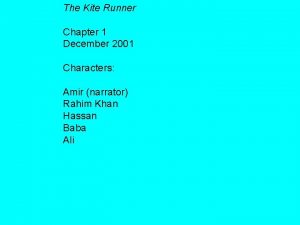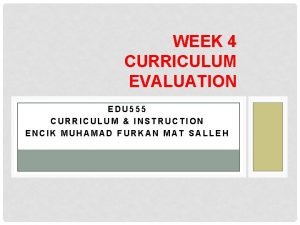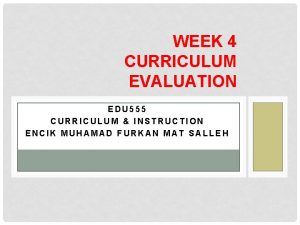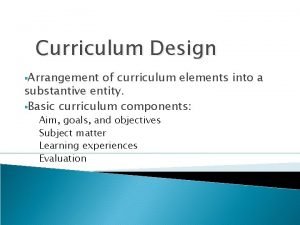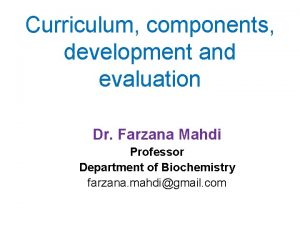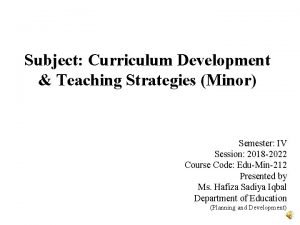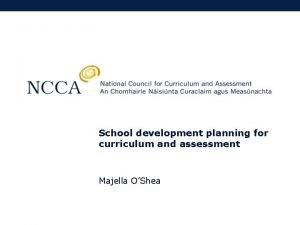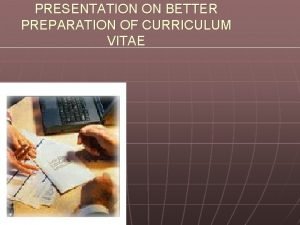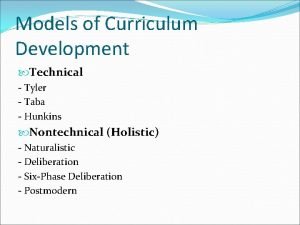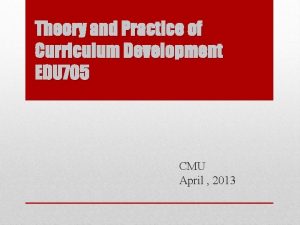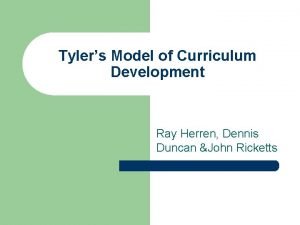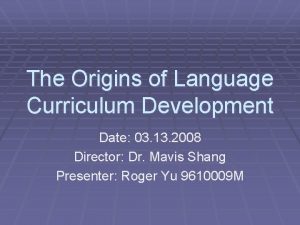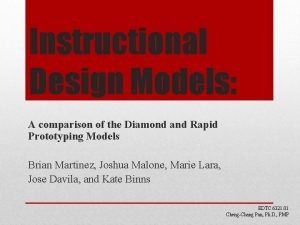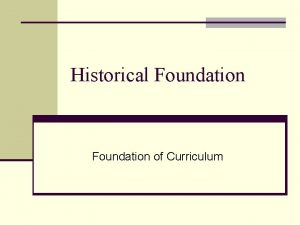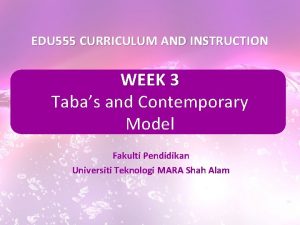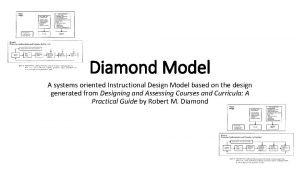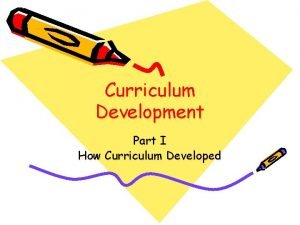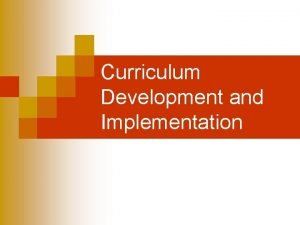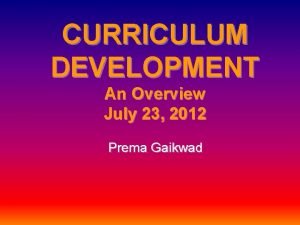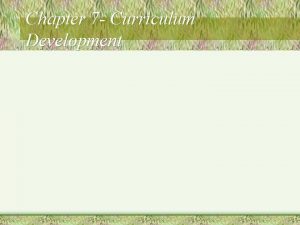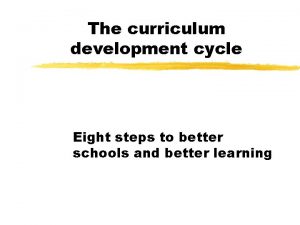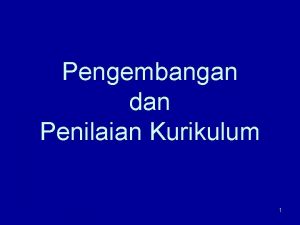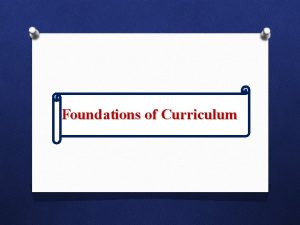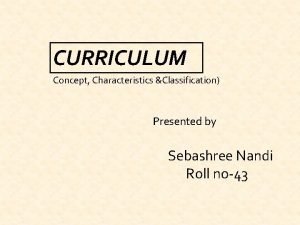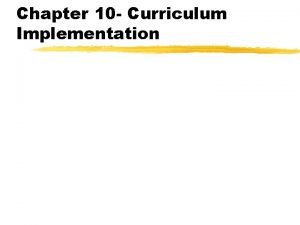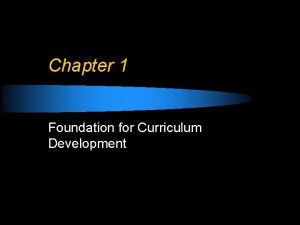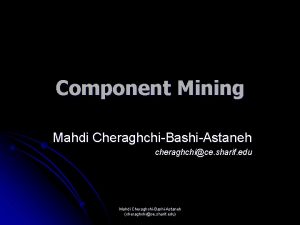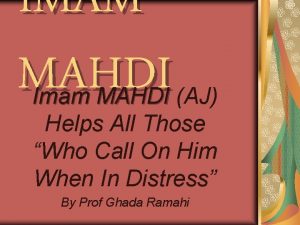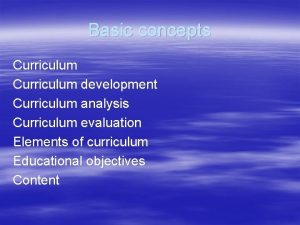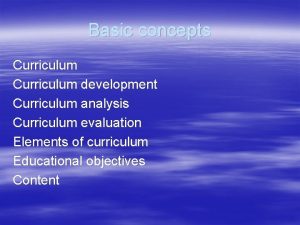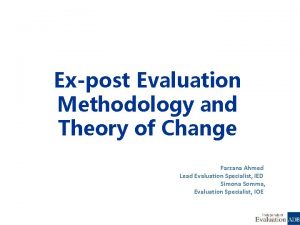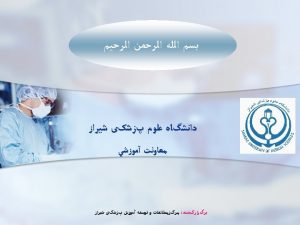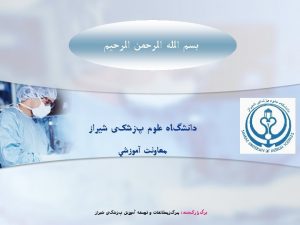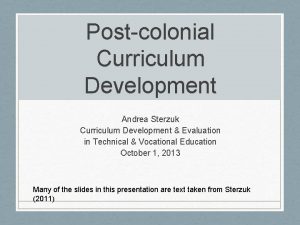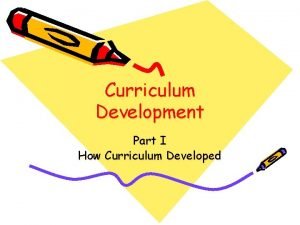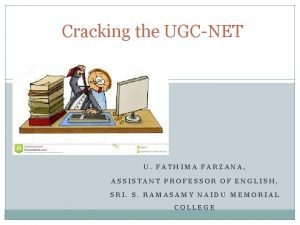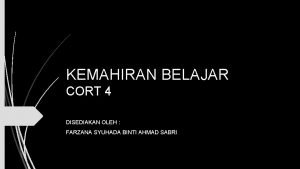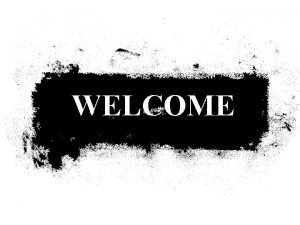Curriculum components development and evaluation Dr Farzana Mahdi
















































- Slides: 48

Curriculum, components, development and evaluation Dr. Farzana Mahdi Professor Department of Biochemistry farzana. mahdi@gmail. com

Curriculum Learning Objectives After this interaction, learner should be able to-- Define and explain the concept of curriculum -- Enumerate curriculum foundations and components -- Explain the curriculum in his/her own subject area -- Discuss the importance and need for curriculum evaluation

Definition “Curriculum is a plan of action which incorporates the learning outcomes to be attained over a period of time by exposing the learner to various learning experiences”

What is a Curriculum? ? A statement of learning objectives ? A statement of learning experiences ? A statement of learning outcomes ? A listing of the subject matter (syllabus)

WHAT IS CURRICULUM? Intended aims & objectives, content, experiences, outcomes and processes of the educational programme Entry requirements Assessment system Flexibilities Education structure Programme organisation Length CURRICULUM Expected methods of learning, teaching, feedback and supervision. Syllabus content: Knowledge, skills, attitudes, expertise to be achieved.

Curriculum Latin word means “ Race- course” What it denotes?

It denotes • Path to be followed • Frame within which it has to be followed

? Curriculum • Provides direction to both teachers as well as students • Assists in selection of appropriate learning resource material • Helps to adopt appropriate teaching-learning activities • Helps in designing appropriate assessment tools • Ultimately helps designing relevant and efficient educational programme

Curriculum Student What to learn *Content How to learn *Educational strategy Teaching Learning tools Assessment Educational Enviornment Learning Outcome

Curriculum Development

Models of curriculum Development • • The Tyler model The Taba Model The Saylor and Alexander Model The Goodlad Model The Hunkins Model The Miller and Seller Model The Zais Model

Zais Model Needs knowledge of – A – Curriculum foundations B – Curriculum components


Curriculum foundations Answer of four basic questions give desired shape to curriculum • Why a subject is being taught? • Who is being taught? • MBBS/BDS • How a subject will be taught? • face to face or distance mode • What is to be achieved Learning outcome

Why is anatomy being taught? Students understand the Inter- relationship of various structures of human body in better way Students score better in AIPGME/ state PGME/ USMLE Emphasis on basics Emphasis on recent advances

Curricular Components • Educational Objectives what will the learner be able to do at the end of instructions. • Educational Materials learning resources like books, manuals, models, A - V aids etc. • Educational Methods denote the way the materials will be used e. g. lectures, practicals, group discussions, self study, field visits etc. • Evaluation to certify the attainment of stipulated proficiency; and to provide a feedback to the learner and the teacher

Which is correct ? A B Objectives Materials Assessment planning Methods Assessment

“Begin with the end in mind”

Which is correct ? A B Objectives Materials Assessment planning Methods Assessment √

Curriculum development • Curriculum planning should be flexible (example of communication skill) • Same learning objective could be achieved by using different teaching methodology.

Curriculum development Approaches Subject centered Learner centered Problem solving

Subject centered approach • Emphasis to complete subject matter • Number of lectures / number of topics / number of hours are assigned (Contemporary MBBS curriculum)

DISCIPLINE BASED O&G SURG FM PATH ANAT BIO MED PHY MICR PED PHARM PHYSIO MATH CHEM CM BIO CH. COMP G. K.

Learner centered approach Approach es • Emphasis on fulfilling the needs of learner. Subject centered Learner centered • Students will be active and responsible participants in their own learning. • Strengthens student motivation, promotes peer communication, builds student‐teacher relationships and promotes active learning. (Learner’s intent to crack PGME/USMLE/ NEET) Problem solving

STUDENT DECIDES ON • Learning objectives • Course contents • Methods to be used to achieve objectives • Learning resources • Sequence and pace of learning. • Time of Assessment BE LEARNER ORIENTED

Problem solving approach Approach es Subject centered • Emphasis on ability of learner to solve a given problem • Involves subject as well as learner centered approach Learner centered Problem solving

None of the approaches are entirely satisfactory

SPICES model of Medical curriculum (Harden et al 1984) Modern System Traditional System Student-centered - Teacher-centered Problem-based Integrated - Information-gathering Discipline-based Community-based - Hospital-based Electives - Standard-program Systematic - Apprenticeship-based (More the curriculum is on left side, the better it is )

INEGRATION HORIZONTOL VERTICAL SPIRAL


INTEGRATED Anatomy Biochemistry

Advantages of Integration • Reduces fragmentation of medical course. • Improves education effectiveness of teaching. • Promotes staff communication and collaboration. Advantages of subject based • Omission of topics is avoided. • Content of discipline is not neglected. • Less costly. • Teacher friendly. • Provides a career choice.

Curriculum Designs Student oriented Problem Based Integrated Community Oriented Elective Systematic Teacher oriented Information Gathering Discipline based Hospital based Uniform Apprenticeship/ Opportunistic THE IDEAL MODEL?

Ideal Curriculum NATIONAL HEALTH POLICY

Ideal Curriculum NATIONAL HEALTH POLICY STATE HEALTH POLICY

Ideal Curriculum NATIONAL HEALTH POLICY STATE HEALTH POLICY UNIVERSITY GOALS

Ideal Curriculum NATIONAL HEALTH POLICY STATE HEALTH POLICY UNIVERSITY GOALS Curriculum Goals Department Goals Objectives - Assessments & Teaching Strategies

Ideal Curriculum NATIONAL HEALTH POLICY STATE HEALTH POLICY UNIVERSITY GOALS Curriculum Goals Department Goals Objectives - Assessments & Teaching Strategies D 1 D 2 D 3 D 4 D 5 Assignments D 6 Dn

ST A Y TE Present situation HE UNIV. AGOAL LT of medical H PO LI Curriculum education CY TH L A P IC OL HE AL N O TI A N Goals Department Goals Objectives - Assessments & Teaching Strategies D 1 D 2 Assignments D 3 D 4 D 5 D 6 Dn

Curricular determinants National health objectives Institutional Objectives Departmental Objectives Subject Content Learning experiences Assessment plan


Curriculum Development: A Six Step Approach David E Kern

Contents • Step 1 Problem Identification and General Needs Assessment • Step 2 Targeted Needs Assessment • Step 3 Goals and Objectives • Step 4 Educational Strategies • Step 5 Implementation • Step 6 Evaluation and Feedback

CURRICULUM IS TOO IMPORTANT NOT TO BE EVALUATED

WHAT CAN EVALUATION ADDRESS? intentions vs achievement: curriculum in practice structure outcomes & effects content relevance EVALUATION teaching process learning cost-benefit the unexpected professional induction qualities of graduates But almost never, cause and effect

THE EVALUATION SYSTEM OUTCOME PURPOSE METHOD CONTEXT Decision Communication Curriculum change & development

APPROACH • There is no one ‘correct’ approach • Your evaluation MUST be based on your defined objectives. Remember: Evaluation is part of a change management process for curriculum renewal

"Curriculum is in the air. No matter what the problem in medical education, curriculum is looked to as the solution“ R M Harden
 Farzana and jamil are from kushtia
Farzana and jamil are from kushtia Farzana and jamil are from kushtia bangla meaning
Farzana and jamil are from kushtia bangla meaning Welcom
Welcom Farzana and jamil are from kustia
Farzana and jamil are from kustia Prescriptive curriculum
Prescriptive curriculum Flagellar arrangements
Flagellar arrangements Hospice satisfaction survey
Hospice satisfaction survey Sahar mahdi
Sahar mahdi Mahdi majbouri
Mahdi majbouri Sahar mahdi
Sahar mahdi Sahar mahdi
Sahar mahdi Sahar mahdi
Sahar mahdi Mahdi forghani
Mahdi forghani Imam mahdi ciri ciri
Imam mahdi ciri ciri Mahdi hammoud
Mahdi hammoud Mahdi bray
Mahdi bray Farzana did poor on her algebra
Farzana did poor on her algebra Farzana jalabi afghanistan
Farzana jalabi afghanistan Farzana did poor on her algebra
Farzana did poor on her algebra What realization does amir come to in chapter 19
What realization does amir come to in chapter 19 Farzana kite runner
Farzana kite runner Definition of curriculum evaluation
Definition of curriculum evaluation Instrument for curriculum evaluation
Instrument for curriculum evaluation Curriculum evaluation
Curriculum evaluation The arrangement of elements of curriculum is
The arrangement of elements of curriculum is Components of curriculum
Components of curriculum Need of curriculum
Need of curriculum Components of curriculum design
Components of curriculum design Components of a curriculum vitae
Components of a curriculum vitae Benefits of hilda taba model
Benefits of hilda taba model Daniel tanner 1980 definition of curriculum explanation
Daniel tanner 1980 definition of curriculum explanation 7 steps of hilda taba model
7 steps of hilda taba model Tyler's model of curriculum development
Tyler's model of curriculum development History of curriculum
History of curriculum Diamond model of curriculum development
Diamond model of curriculum development Historical foundation of curriculum development
Historical foundation of curriculum development Taba's model of curriculum development
Taba's model of curriculum development Systematic design model strengths and weaknesses
Systematic design model strengths and weaknesses Curriculum development in pakistan
Curriculum development in pakistan Taba's model of curriculum development
Taba's model of curriculum development Phases of curriculum development
Phases of curriculum development Curriculum development process
Curriculum development process Models of curriculum design
Models of curriculum design What is curriculum cycle
What is curriculum cycle 8 siklus pengembangan kurikulum
8 siklus pengembangan kurikulum Foundations of curriculum
Foundations of curriculum What is curricullum
What is curricullum Orc model of curriculum implementation
Orc model of curriculum implementation Define curriculum
Define curriculum


